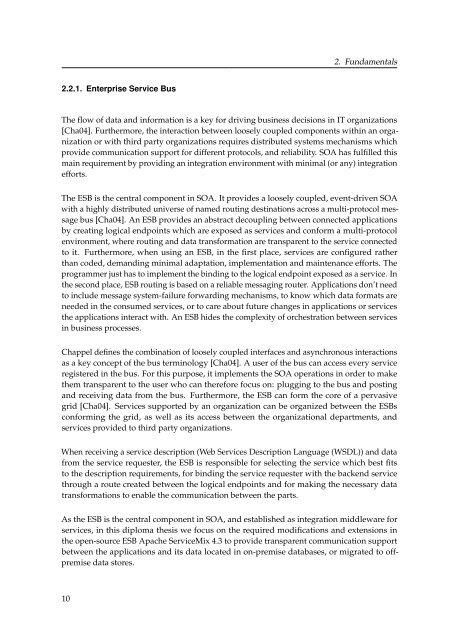Diploma Thesis Santiago Gómez Sáez - IAAS
Diploma Thesis Santiago Gómez Sáez - IAAS
Diploma Thesis Santiago Gómez Sáez - IAAS
You also want an ePaper? Increase the reach of your titles
YUMPU automatically turns print PDFs into web optimized ePapers that Google loves.
2. Fundamentals<br />
2.2.1. Enterprise Service Bus<br />
The flow of data and information is a key for driving business decisions in IT organizations<br />
[Cha04]. Furthermore, the interaction between loosely coupled components within an organization<br />
or with third party organizations requires distributed systems mechanisms which<br />
provide communication support for different protocols, and reliability. SOA has fulfilled this<br />
main requirement by providing an integration environment with minimal (or any) integration<br />
efforts.<br />
The ESB is the central component in SOA. It provides a loosely coupled, event-driven SOA<br />
with a highly distributed universe of named routing destinations across a multi-protocol message<br />
bus [Cha04]. An ESB provides an abstract decoupling between connected applications<br />
by creating logical endpoints which are exposed as services and conform a multi-protocol<br />
environment, where routing and data transformation are transparent to the service connected<br />
to it. Furthermore, when using an ESB, in the first place, services are configured rather<br />
than coded, demanding minimal adaptation, implementation and maintenance efforts. The<br />
programmer just has to implement the binding to the logical endpoint exposed as a service. In<br />
the second place, ESB routing is based on a reliable messaging router. Applications don’t need<br />
to include message system-failure forwarding mechanisms, to know which data formats are<br />
needed in the consumed services, or to care about future changes in applications or services<br />
the applications interact with. An ESB hides the complexity of orchestration between services<br />
in business processes.<br />
Chappel defines the combination of loosely coupled interfaces and asynchronous interactions<br />
as a key concept of the bus terminology [Cha04]. A user of the bus can access every service<br />
registered in the bus. For this purpose, it implements the SOA operations in order to make<br />
them transparent to the user who can therefore focus on: plugging to the bus and posting<br />
and receiving data from the bus. Furthermore, the ESB can form the core of a pervasive<br />
grid [Cha04]. Services supported by an organization can be organized between the ESBs<br />
conforming the grid, as well as its access between the organizational departments, and<br />
services provided to third party organizations.<br />
When receiving a service description (Web Services Description Language (WSDL)) and data<br />
from the service requester, the ESB is responsible for selecting the service which best fits<br />
to the description requirements, for binding the service requester with the backend service<br />
through a route created between the logical endpoints and for making the necessary data<br />
transformations to enable the communication between the parts.<br />
As the ESB is the central component in SOA, and established as integration middleware for<br />
services, in this diploma thesis we focus on the required modifications and extensions in<br />
the open-source ESB Apache ServiceMix 4.3 to provide transparent communication support<br />
between the applications and its data located in on-premise databases, or migrated to offpremise<br />
data stores.<br />
10

















